Study on Evolution of Front Abutment Pressure at Working Face in Repeated Mining of Close-Distance Coal Seams
Abstract
:1. Introduction
2. Project Overview
2.1. Engineering Background
2.2. Phenomena Analysis
3. Key Factors of Abutment Pressure in Repeated Mining
3.1. Stress Arch Equation under Nonlinear Load
3.2. Abutment Pressure Distribution Calculation and Analysis of Key Factors
3.3. Method for Obtaining Shape Parameters of Stress Arch
4. Evolution of Shape Parameters of Stress Arch in Repeated Mining
4.1. Numerical Simulation
4.1.1. Numerical Simulation Model Development
4.1.2. 1214 Working Face Mining
4.1.3. 2214 Working Face Mining
4.2. Evolution of Shape Parameters of Stress Arch by Physical Simulation Similarity Test
4.2.1. Physical Similarity Model
4.2.2. 1214 Working Face Mining
4.2.3. 2214 Working Face Mining
4.3. Determination of Stress Arch Shape Parameters
4.4. Determination of Influence Range of Abutment Pressure in Repeated Mining
5. Numerical Analysis of Surrounding Rock Stress of the Main Roadway and Discussion
5.1. Numerical Analysis
5.2. Discussion
6. Conclusions
Author Contributions
Funding
Institutional Review Board Statement
Informed Consent Statement
Data Availability Statement
Acknowledgments
Conflicts of Interest
References
- Nezhad, M.M.; Fisher, Q.J.; Gironacci, E.; Rezania, M. Experimental Study and Numerical Modeling of Fracture Propagation in Shale Rocks During Brazilian Disk Test. Rock Mech. Rock Eng. 2018, 51, 1755–1775. [Google Scholar] [CrossRef]
- Wang, F.; Wang, M.; Zhu, Z.M.; Deng, J.H.; Nezhad, M.M.; Qiu, H.; Ying, P. Rock Dynamic Crack Propagation Behaviour and Determination Method with Improved Single Cleavage Semi-circle Specimen Under Impact Loads. Acta Mech. Solida Sin. 2020, 33, 793–811. [Google Scholar] [CrossRef]
- Wang, M.; Zhu, Z.M.; Dong, Y.Q.; Zhou, L. Study of mixed-mode I/II fractures using single cleavage semicircle compression specimens under impacting loads. Eng. Fract. Mech. 2017, 177, 33–44. [Google Scholar] [CrossRef]
- Yang, R.S.; Xu, P.; Yue, Z.W.; Chen, C. Dynamic fracture analysis of crack-defect interaction for mode I running crack using digital dynamic caustics method. Eng. Fract. Mech. 2016, 161, 63–75. [Google Scholar] [CrossRef]
- Gao, C.; Huang, D.; Chang, X.; Xi, H. Risk Analysis and Extension Assessment for the Stability of Surrounding Rock in Deep Coal Roadway. Int. J. Environ. Res. Public Health 2019, 16, 4752. [Google Scholar] [CrossRef] [PubMed]
- Luo, Y.; Xu, K.; Huang, J.; Li, X.; Liu, T.; Qu, D.; Chen, P. Impact analysis of pressure-relief blasting on roadway stability in a deep mining area under high stress. Tunn. Undergr. Space Technol. 2021, 110, 103781. [Google Scholar] [CrossRef]
- Zhao, C.; Li, Y.; Liu, G.; Meng, X. Mechanism analysis and control technology of surrounding rock failure in deep soft rock roadway. Eng. Fail. Anal. 2020, 115, 104611. [Google Scholar] [CrossRef]
- Wang, H.; Jiang, C.; Zheng, P.; Li, N.; Zhan, Y. Deformation and failure mechanism of surrounding rocks in crossed-roadway and its support strategy. Eng. Fail. Anal. 2020, 116, 104743. [Google Scholar] [CrossRef]
- Hao, J.; Li, X.; Song, Y.; Zhang, P.; Liu, H. Analysis of mining roadway with large deformation of broken soft coal and research on supporting technology: A case study in Xin’an coal mine, China. Eng. Fail. Anal. 2021, 130, 105761. [Google Scholar] [CrossRef]
- Guangchao, Z.; Chuanwei, Z.; Miao, C.; Guangzhe, T.; You, L.; Weihua, H.; Hongzhou, W.; Deshuai, Z. Ground response of entries driven adjacent to a retreating longwall panel. Int. J. Rock Mech. Min. 2021, 138, 104630. [Google Scholar] [CrossRef]
- Ma, Q.; Tan, Y.; Liu, X.; Gu, Q.; Li, X. Effect of coal thicknesses on energy evolution characteristics of roof rock-coal-floor rock sandwich composite structure and its damage constitutive model. Compos. Part B Eng. 2020, 198, 108086. [Google Scholar] [CrossRef]
- Qian, M.; Xu, J. Behaviors of strata movement in coal mining. J. China Coal Soc. 2019, 44, 973–984. [Google Scholar]
- Song, Z.; Lu, G.; Xia, H. A new algorithm for calculating the distribution of face abutment pressure. J. Shandong Univ. Sci. Technol. (Nat. Sci.) 2006, 1–4. Available online: https://kns.cnki.net/kcms/detail/detail.aspx?dbcode=CJFD&dbname=CJFD2006&filename=SDKY200601000&uniplatform=NZKPT&v=Pl9e6V5jitLh4DaH0FNrxzWKxL-MTx5bv9ohI_if1BdGFnPtcJLikaaS1vmZUZeA (accessed on 25 July 2022). [CrossRef]
- Zhu, S.; Feng, Y.; Jiang, F. Determination of Abutment Pressure in Coal Mines with Extremely Thick Alluvium Stratum: A Typical Kind of Rockburst Mines in China. Rock Mech. Rock Eng. 2016, 49, 1943–1952. [Google Scholar] [CrossRef]
- Ji, Y.G.; Wang, X.J.; Zhou, Y.P.; Zhang, X.T. Study on the Distribution Law of Front Abutment Pressure of Long Fully-Mechanized Working Face in Deep Mine. In Proceedings of the 8th Russian-Chinese Symposium Coal in the 21st Century: Mining, Processing, Safety, Kemerovo, Russia, 10–12 October 2016; Tailakov, O.V., Ed.; Atlantis Press: Zhengzhou, China, 2016; Volume 92, pp. 159–162. [Google Scholar]
- Xie, J.; Xu, J. Effect of key stratum on the mining abutment pressure of a coal seam. Geosci. J. 2017, 21, 267–276. [Google Scholar] [CrossRef]
- Li, Y.; Lei, M.; Wang, H.; Li, C.; Li, W.; Tao, Y.; Wang, J. Abutment pressure distribution for longwall face mining through abandoned roadways. Int. J. Min. Sci. Technol. 2019, 29, 59–64. [Google Scholar] [CrossRef]
- Li, A.; Ma, Q.; Ma, L.; Kang, L.; Mu, Q.; Chen, J. Coal Mine Abutment Pressure Distribution Based on a Strain-Softening Model. Front. Phys. 2020, 8, 263. [Google Scholar] [CrossRef]
- Zhang, P.; Sun, B. Distribution characteristics of the advance abutment pressure in a deep stope. J. Geophys. Eng. 2020, 17, 686–699. [Google Scholar] [CrossRef]
- Liu, J.; Jiang, F.; Zhu, S. Study of dynamic and static abutment pressure around longwall face and its application. Chin. J. Rock Mech. Eng. 2015, 34, 1815–1827. [Google Scholar]
- Xue, D.; Zhou, H.; Peng, R.; Wang, J.; Deng, L.; Zhao, Y. Strong disturbance of discontinuous abutment pressure. Chin. J. Rock Mech. Eng. 2018, 37, 1080–1095. [Google Scholar]
- Han, H.; Xu, J.; Wang, X.; Xie, J.; Xing, Y. Method to Calculate Working Surface Abutment Pressure Based on Key Strata Theory. Adv. Civ. Eng. 2019, 2019, 7678327. [Google Scholar] [CrossRef]
- Wang, L.; Xie, G.; Wang, J. Numerical investigation on the influence of surrounding rock stress hell on fractured field. J. China Coal Soc. 2015, 40, 2009–2014. [Google Scholar]
- Wang, F.; Chen, T.; Ma, B.; Chen, D. Formation mechanism of stress arch during longwall mining based on key strata theory. Energy Explor. Exploit. 2022, 40, 816–833. [Google Scholar] [CrossRef]
- Wang, S.R.; Wu, X.G.; Zhao, Y.H.; Hagan, P.; Cao, C. Evolution Characteristics of Composite Pressure-Arch in Thin Bedrock of Overlying Strata During Shallow Coal Mining. Int. J. Appl. Mech. 2019, 11, 1950030. [Google Scholar] [CrossRef]
- Xia, B.; Zhang, X.; Yu, B.; Jia, J. Weakening effects of hydraulic fracture in hard roof under the influence of stress arch. Int. J. Min. Sci. Technol. 2018, 28, 951–958. [Google Scholar] [CrossRef]
- Wang, S.; Wu, X.; Zhao, Y.; Hagan, P. Mechanical Performances of Pressure Arch in Thick Bedrock during Shallow Coal Mining. Geofluids 2018, 2018, 2419659. [Google Scholar] [CrossRef]
- Zhao, Y.; Wang, S.; Hagan, P.; Ren, L.; Zou, Z. Pressure-Arching Characteristics in Roof Blocks during Shallow Coal Mining. Adv. Civ. Eng. 2018, 2018, 6817059. [Google Scholar] [CrossRef]
- Jin, C.; Shao, A.; Liu, D.; Han, T.; Fan, F.; Li, S. Failure Mechanism of Highly Stressed Rock Mass during Unloading Based on the Stress Arch Theory. Int. J. Geomech. 2018, 18, 04018146. [Google Scholar] [CrossRef]
- Yang, D.; Guo, W.; Yu, Q.; Tan, Y.; Deng, W. Structural characteristics and evolution mechanism of overlying strata pressure arch in shallow and flat seams. J. Min. Saf. Eng. 2019, 36, 323–330. [Google Scholar]
- Zhao, Y.; Yu, J.; Zhou, C.; Zhao, K.; Xiao, H. Characterization of pressure arching effect of arch shell surrounding rock considering deviation of principal stress axis. Chin. J. Geotech. Eng. 2021, 43, 1842–1850. [Google Scholar]
- Zhu, Z. Structure Characteristics and Control Technology of Surrounding Rocks in Non-Pillar Mining by Roof Cutting. Ph.D. Thesis, China University of Mining and Technology, Beijing, China, 2019. [Google Scholar]
- Pang, R.; Xu, B.; Zhou, Y.; Song, L.F. Seismic time-history response and system reliability analysis of slopes considering uncertainty of multi-parameters and earthquake excitations. Comput. Geotech. 2021, 136, 104245. [Google Scholar] [CrossRef]
- Pang, R.; Xu, B.; Zhou, Y.; Zhang, X.; Wang, X.L. Fragility analysis of high CFRDs subjected to mainshock-aftershock sequences based on plastic failure. Eng. Struct. 2020, 206, 110152. [Google Scholar] [CrossRef]
- Qian, M. Ground Pressure and Strata Control; China University of Mining and Technology Press: Xuzhou, China, 2010. [Google Scholar]
- Li, L.; Shang, C.; Chu, K.; Zhou, Z.; Song, S.; Liu, Z.; Chen, Y. Large-scale geo-mechanical model tests for stability assessment of super-large cross-section tunnel. Tunn. Undergr. Space Technol. 2021, 109, 103756. [Google Scholar] [CrossRef]
- Wen, Z.; Jing, S.; Jiang, Y.; Tian, L.; Wen, J.; Cao, Z.; Shi, S.; Zuo, Y. Study of the Fracture Law of Overlying Strata under Water Based on the Flow-Stress-Damage Model. Geofluids 2019, 2019, 3161852. [Google Scholar] [CrossRef]
- Wang, Z.; Guo, L.; Su, Z.; Wang, J.; Xu, J. Application of visible post-processing method of FLAC3D model node displacement in surface subsidence. J. Min. Sci. Technol. 2016, 1, 249–255. [Google Scholar]
- Wang, S.; Liu, Y.; Yang, Q.; Wang, X. Analysis of the Abutment Movements of High Arch Dams due to Reservoir Impoundment. Rock Mech. Rock Eng. 2020, 53, 2313–2326. [Google Scholar] [CrossRef]
- Zhao, Y.; Wang, T.; Jiang, Y.; Pan, L.; Zhang, K. Application of Hoek-Brown criterion in numerical simulation of ground pressure features in multi-seam longwall mining. J. China Coal Soc. 2013, 38, 970–976. [Google Scholar]
- Wang, H.; Poulsen, B.A.; Shen, B.; Xue, S.; Jiang, Y. The influence of roadway backfill on the coal pillar strength by numericalinvestigation. Int. J. Rock Mech. Min. 2011, 48, 443–450. [Google Scholar] [CrossRef]
- Mohammad, N.; Reddish, D.J.; Stace, L.R. The relation between in situ and laboratory rock properties used in numerical modelling. Int. J. Rock Mech. Min. 1997, 34, 289–297. [Google Scholar] [CrossRef]
- Cai, M.; He, M. Rock Mechanics and Engineering; Science Press: Beijing, China, 2013. [Google Scholar]
- Wang, S.L.; Hao, S.P.; Chen, Y.; Bai, J.B.; Wang, X.Y.; Xu, Y. Numerical investigation of coal pillar failure under simultaneous static and dynamic loading. Int. J. Rock Mech. Min. 2016, 84, 59–68. [Google Scholar] [CrossRef]
- Shabanimashcool, M.; Li, C.C. A numerical study of stress changes in barrier pillars and a border area in a longwall coal mine. Int. J. Coal Geol. 2013, 106, 39–47. [Google Scholar] [CrossRef]
- Zhang, Z.Z.; Bai, J.B.; Chen, Y.; Yan, S. An innovative approach for gob-side entry retaining in highly gassy fully-mechanized longwall top-coal caving. Int. J. Rock Mech. Min. 2015, 80, 1–11. [Google Scholar] [CrossRef]
- Wang, C.X.; Shen, B.T.; Chen, J.T.; Tong, W.X.; Jiang, Z.; Liu, Y.; Li, Y.Y. Compression characteristics of filling gangue and simulation of mining with gangue backfilling: An experimental investigation. Geomech. Eng. 2020, 20, 485–495. [Google Scholar]
- Chen, J.H.; Liu, P.; Liu, L.; Zeng, B.Q.; Zhao, H.B.; Zhang, C.; Zhang, J.W.; Li, D.Q. Anchorage performance of a modified cable anchor subjected to different joint opening conditions. Constr. Build. Mater. 2022, 336, 127558. [Google Scholar] [CrossRef]
- Chen, J.H.; Zeng, B.Q.; Liu, L.; Tao, K.M.; Zhao, H.B.; Zhang, C.; Zhang, J.W.; Li, D.Q. Investigating the anchorage performance of full-grouted anchor bolts with a modified numerical simulation method. Eng. Fail. Anal. 2022, 141, 106640. [Google Scholar] [CrossRef]




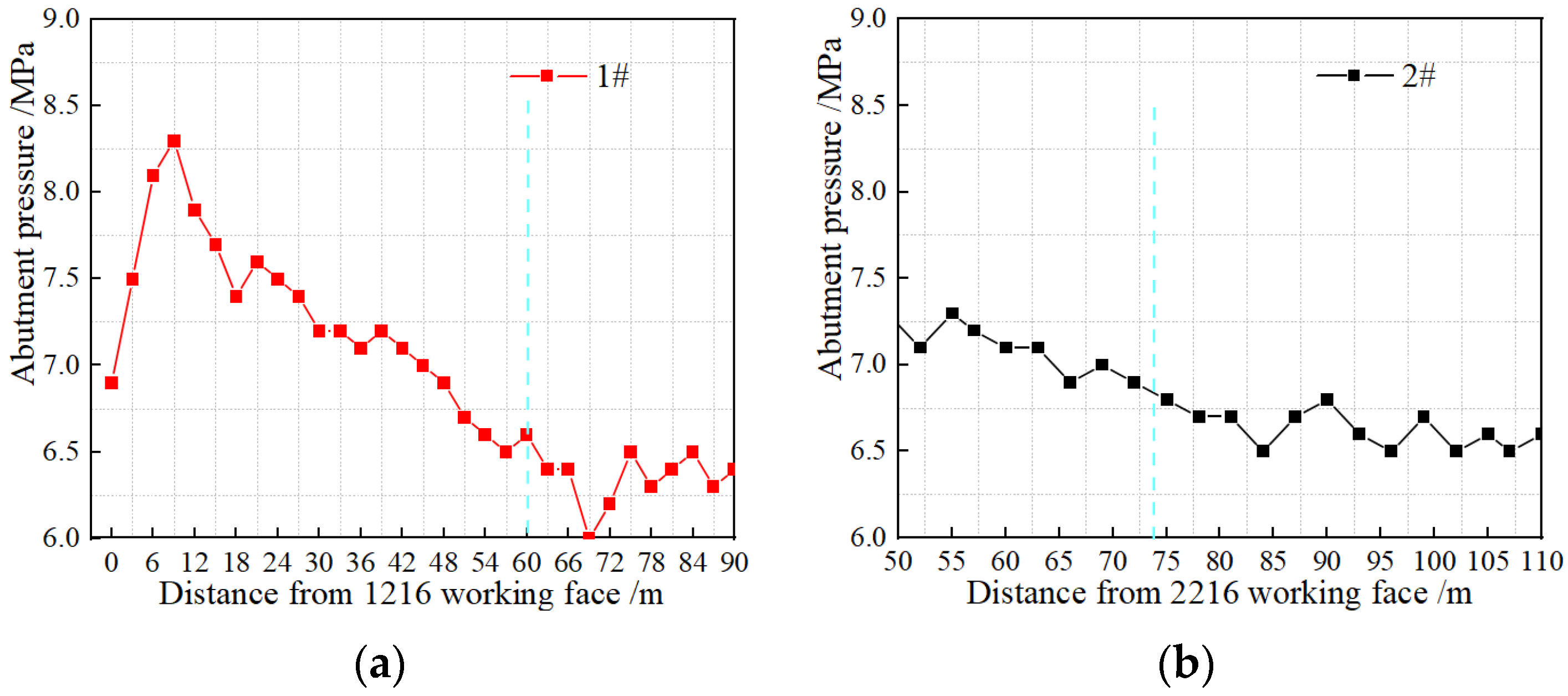

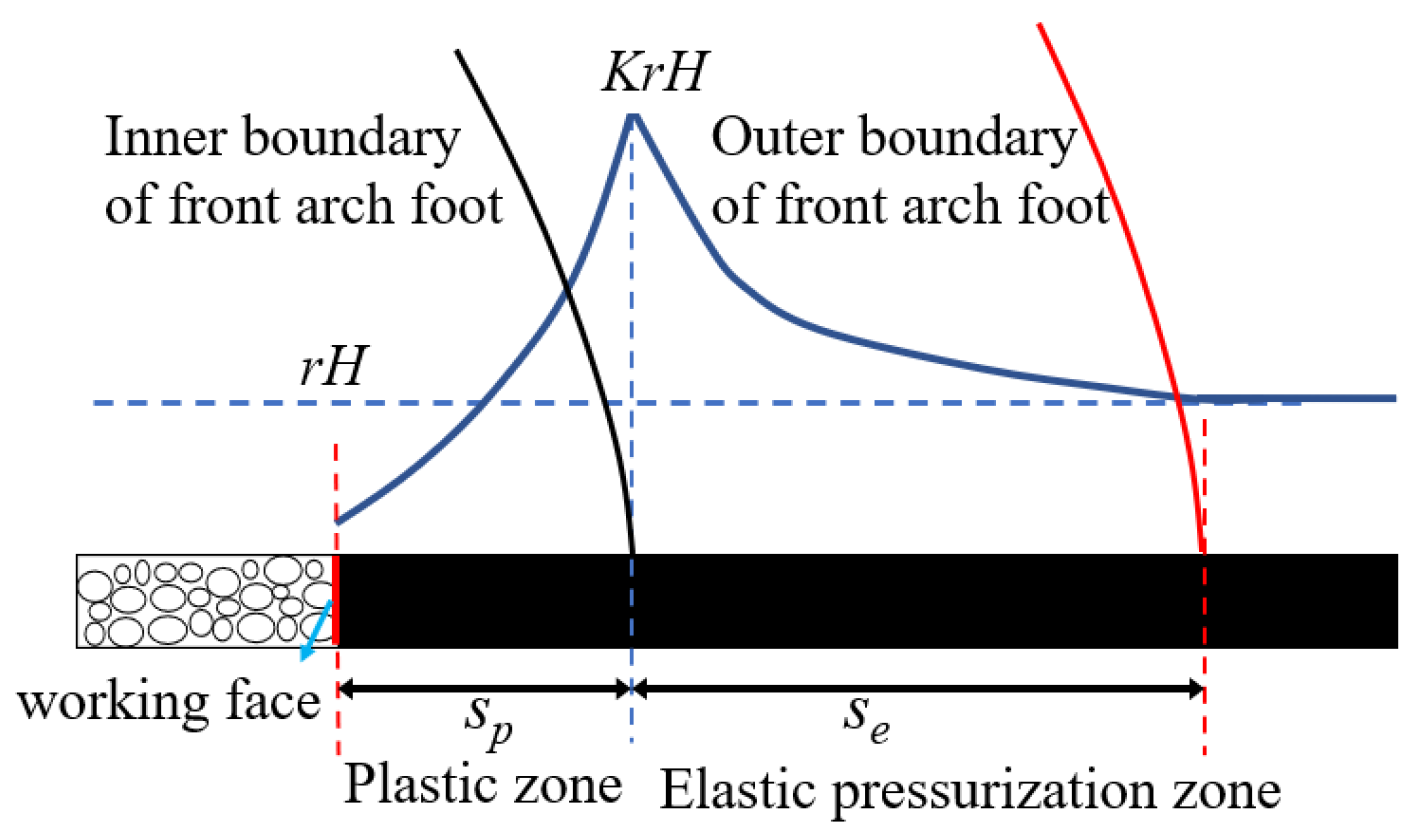

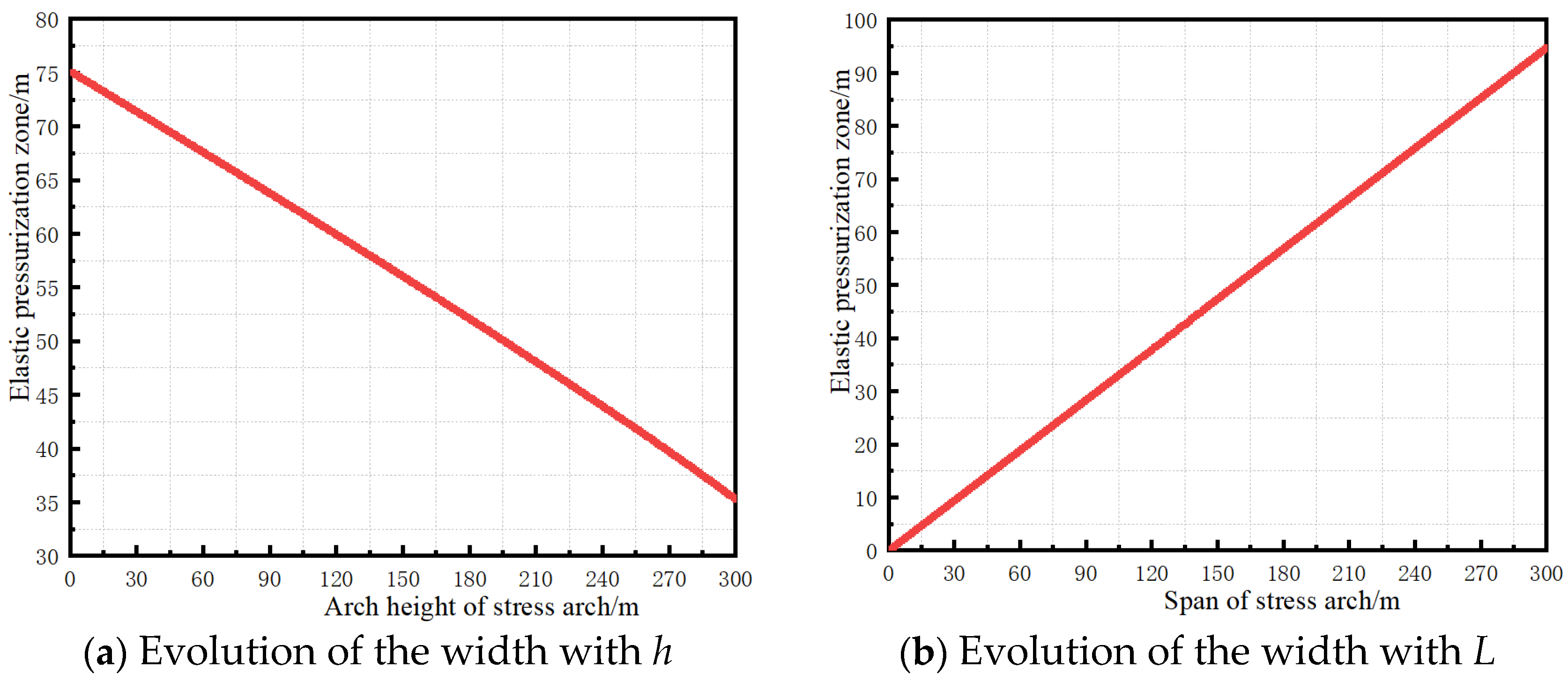
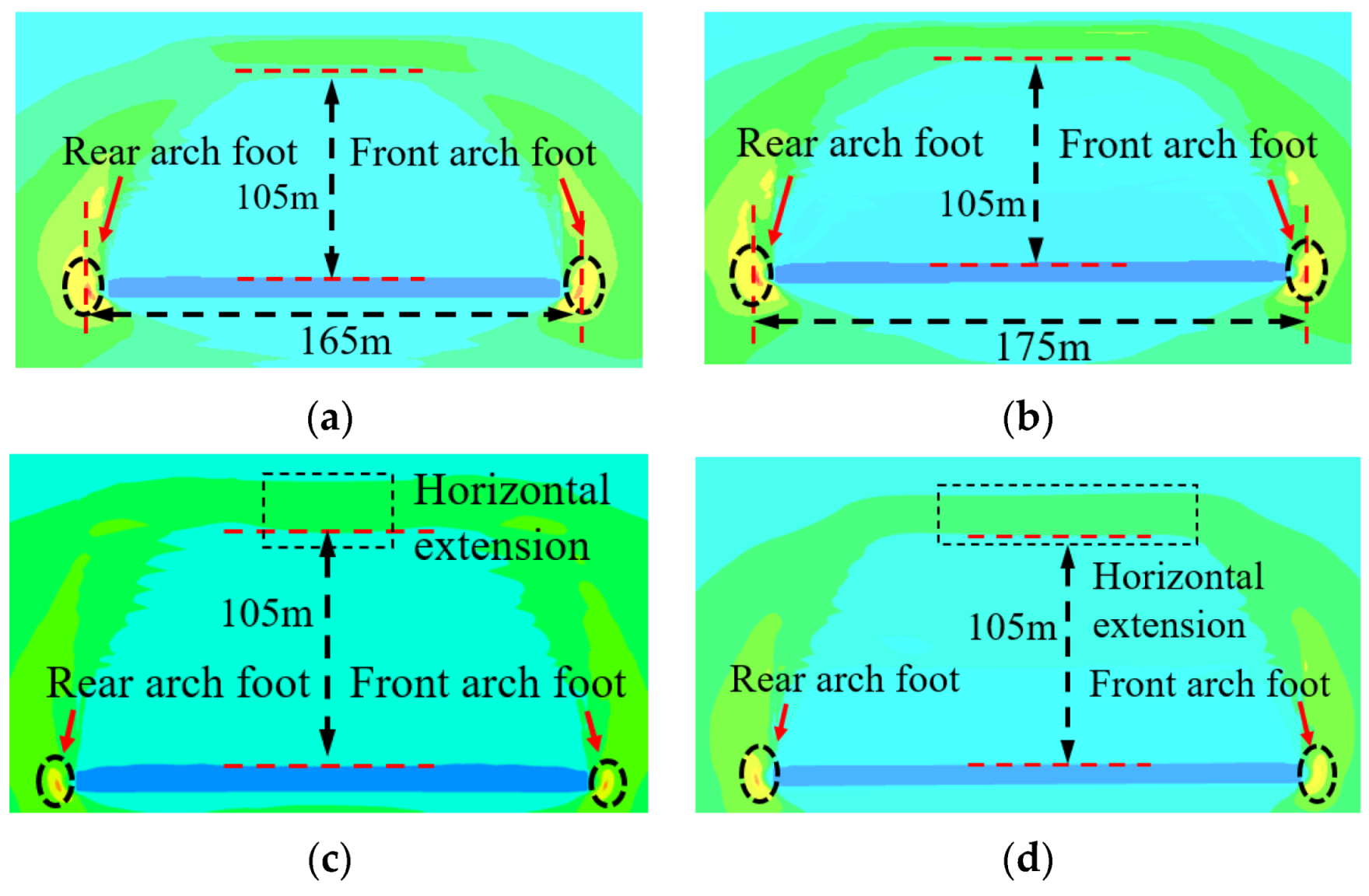




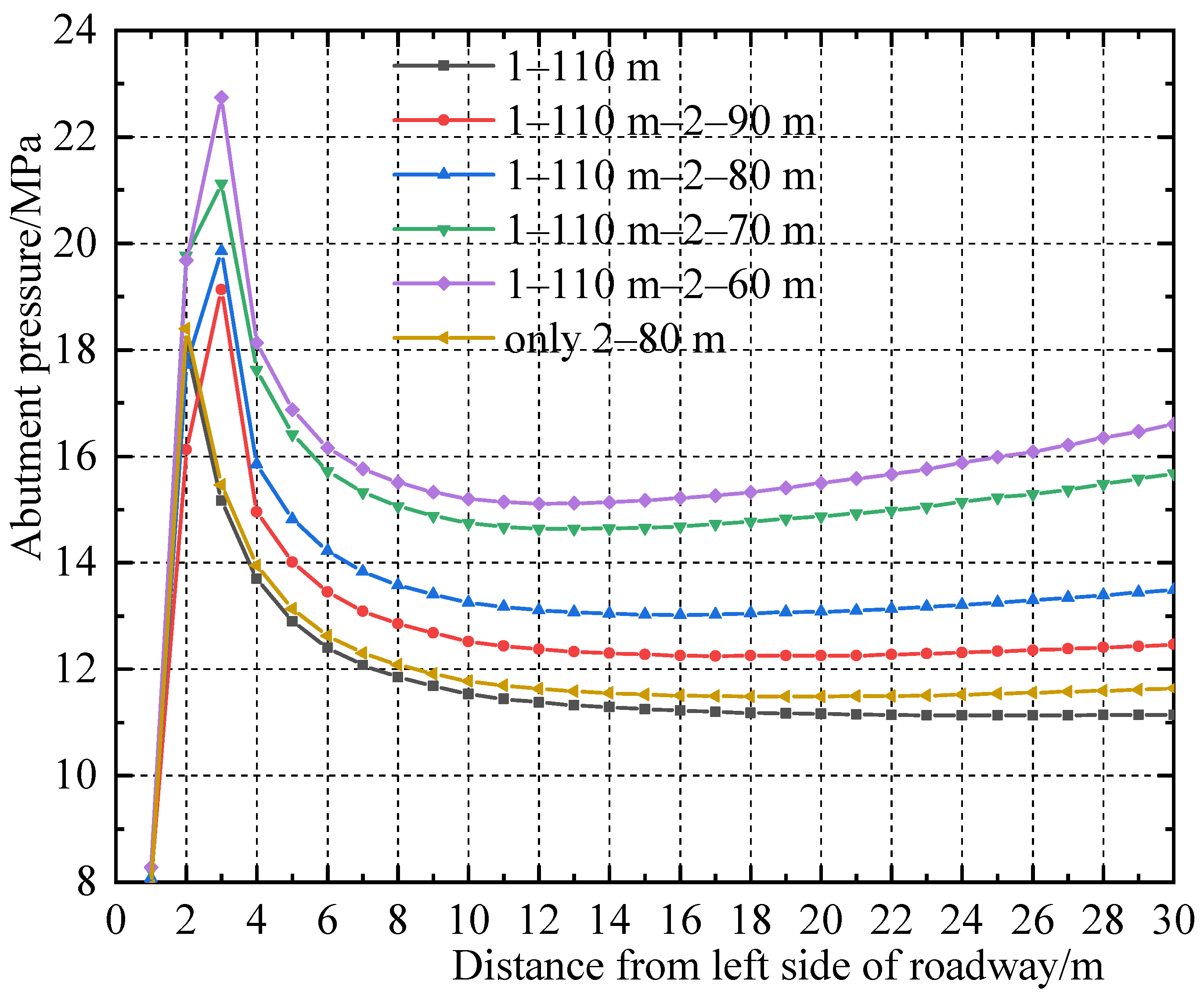

| Layer | Natural Density | Shear Modulus | Bulk Modulus | Cohesion | Internal Friction Angle | Tensile Strength |
|---|---|---|---|---|---|---|
| kg/m3 | /GPa | /GPa | /MPa | /(°) | /MPa | |
| Overlying strata | 2500 | 7.80 | 9.00 | 3.40 | 32 | 1.53 |
| Coarse sandstone | 2580 | 8.40 | 11.23 | 4.10 | 36 | 1.55 |
| Fine sandstone | 2612 | 8.24 | 11.79 | 4.23 | 31 | 1.55 |
| Siltstone | 2300 | 4.26 | 5.79 | 2.23 | 31 | 1.20 |
| No. 1 coal seam | 1550 | 3.36 | 4.51 | 1.00 | 27 | 0.08 |
| Fine sandstone | 2612 | 8.24 | 11.79 | 4.23 | 31 | 1.50 |
| Medium-fine sandstone | 2580 | 7.90 | 9.30 | 2.40 | 32 | 1.30 |
| Kaolinite rock | 2450 | 6.89 | 8.76 | 2.30 | 30 | 1.30 |
| Conglomerate | 2520 | 7.54 | 9.23 | 2.90 | 31 | 1.40 |
| Carbonaceous mudstone | 2360 | 4.35 | 5.87 | 1.80 | 29 | 1.20 |
| No. 2 coal seam | 1550 | 3.36 | 4.51 | 1.00 | 27 | 0.08 |
| Carbonaceous mudstone | 2360 | 4.35 | 5.87 | 1.80 | 29 | 1.20 |
| Kaolinite rock | 2450 | 6.89 | 8.76 | 2.30 | 30 | 1.30 |
| Medium-fine sandstone | 2580 | 7.90 | 9.30 | 2.40 | 32 | 1.30 |
| Strain | 0.00 | 0.01 | 0.03 | 0.05 | 0.07 | 0.09 | 0.11 | 0.13 | 0.15 | 0.17 |
|---|---|---|---|---|---|---|---|---|---|---|
| Stress (MPa) | 0.00 | 0.53 | 1.78 | 3.37 | 5.44 | 8.26 | 12.34 | 18.76 | 30.30 | 57.23 |
| Parameter | Natural Density kg/m3 | Shear Modulus/GPa | Bulk Modulus/GPa | Friction Angle/° | Dilatancy Angle/° |
|---|---|---|---|---|---|
| Value | 1100 | 1.15 | 3.74 | 20 | 8 |
| Mining Stage | Before Repeated Mining | After Repeated Mining | ||
|---|---|---|---|---|
| Shape Parameters | h/m | L/m | h/m | L/m |
| Numerical simulation | 105 | 175 | 165 | 235 |
| Physical similarity simulation | 105 | 180 | 165 | 240 |
| Final value | 105 | 175 | 165 | 235 |
| Working Face Mining | H/m | h/m | L/m | K | LC/m |
|---|---|---|---|---|---|
| Only 1214 | 400 | 105 | 175 | 4 | 69 |
| 1214, 2214 | 425 | 165 | 235 | 4 | 83.5 |
Publisher’s Note: MDPI stays neutral with regard to jurisdictional claims in published maps and institutional affiliations. |
© 2022 by the authors. Licensee MDPI, Basel, Switzerland. This article is an open access article distributed under the terms and conditions of the Creative Commons Attribution (CC BY) license (https://creativecommons.org/licenses/by/4.0/).
Share and Cite
He, F.; Li, L.; Lv, K.; Qin, B.; Xu, X.; Ma, Q.; Chen, Y. Study on Evolution of Front Abutment Pressure at Working Face in Repeated Mining of Close-Distance Coal Seams. Sustainability 2022, 14, 12399. https://doi.org/10.3390/su141912399
He F, Li L, Lv K, Qin B, Xu X, Ma Q, Chen Y. Study on Evolution of Front Abutment Pressure at Working Face in Repeated Mining of Close-Distance Coal Seams. Sustainability. 2022; 14(19):12399. https://doi.org/10.3390/su141912399
Chicago/Turabian StyleHe, Fulian, Liang Li, Kai Lv, Binbin Qin, Xuhui Xu, Qing Ma, and Yongqiang Chen. 2022. "Study on Evolution of Front Abutment Pressure at Working Face in Repeated Mining of Close-Distance Coal Seams" Sustainability 14, no. 19: 12399. https://doi.org/10.3390/su141912399
APA StyleHe, F., Li, L., Lv, K., Qin, B., Xu, X., Ma, Q., & Chen, Y. (2022). Study on Evolution of Front Abutment Pressure at Working Face in Repeated Mining of Close-Distance Coal Seams. Sustainability, 14(19), 12399. https://doi.org/10.3390/su141912399









